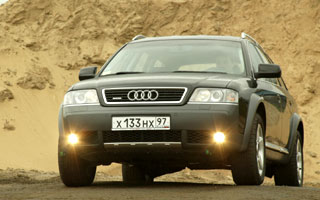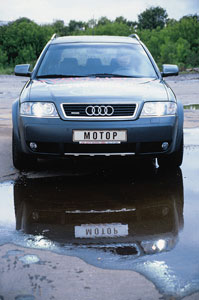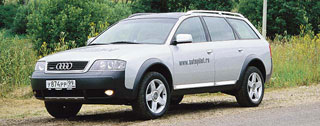Audi Allroad 2000 test drive - 2006 SUV
The battle of iron chancellors
As soon as they are not called parquet, beach, walking, etc., and in the subtext of each of these definitions, neglect sounds. And in vain real all -terrain vehicles are needed only by a very limited circle of buyers. Parquet compromise for daily operation.Full -wheel drive cars are divided into two obvious categories: with a body or at least a platform of an ordinary passenger car and with a specially created body (high with short overhangs), taking into account off -road specifics. The first category is largely unified with popular cars, respectively cheaper and better adapted for road operation. The second is more consistent with the modes of bad roads and off -road, and is also distinguished by now fashionable SUV. However, within each of these categories, the 4x4 compromise between the roads of different representatives of different representatives is different.
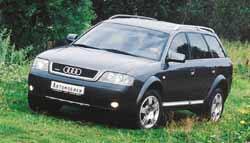 Therefore, we decided to compare the most powerful crook from the first (road) category of Audi Allroad with SUVs from the second BMW X5, Mercedes ML 430 and Lexus RX 300. BMW is still offered in the most powerful version with a 4.4 liter engine and with an automatic gearbox. Accordingly, the Audi modifications (with a gasoline turbocharger engine of 2.7 l) and Mercedes (with an engine of 4.3 l) were selected. That's just Lexus, which is produced exclusively with a 3-liter atmospheric engine, significantly lags behind them in power and a torque. However, Lexus and the least expensive from 52 thousand dollars in Moscow. Audi Allroad, due to direct kinship with the Audi A6, only a little more expensive from $ 56 thousand. Prices for BMW X5 and Mercedes ML 430 in good configuration are running out for 75 thousand.
Therefore, we decided to compare the most powerful crook from the first (road) category of Audi Allroad with SUVs from the second BMW X5, Mercedes ML 430 and Lexus RX 300. BMW is still offered in the most powerful version with a 4.4 liter engine and with an automatic gearbox. Accordingly, the Audi modifications (with a gasoline turbocharger engine of 2.7 l) and Mercedes (with an engine of 4.3 l) were selected. That's just Lexus, which is produced exclusively with a 3-liter atmospheric engine, significantly lags behind them in power and a torque. However, Lexus and the least expensive from 52 thousand dollars in Moscow. Audi Allroad, due to direct kinship with the Audi A6, only a little more expensive from $ 56 thousand. Prices for BMW X5 and Mercedes ML 430 in good configuration are running out for 75 thousand. Appearance, interior
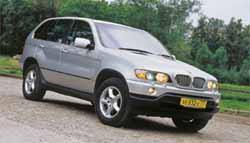 So, the first impressions are appearance. Lexus is undoubtedly peculiar. However, this, obviously eastern originality is slightly frivolous of non -woman's character. Competitors look more restrained and aristocratic in European. The most expressive among them, at least from our point of view, is the BMW X5, in the appearance of which it is organically combined with branded features with non -road proportions unusual for BMW. A successful expansion of the body sidewalls to the bottom can be considered a successful find, covering the wheel arches, which makes the car even more stable.
So, the first impressions are appearance. Lexus is undoubtedly peculiar. However, this, obviously eastern originality is slightly frivolous of non -woman's character. Competitors look more restrained and aristocratic in European. The most expressive among them, at least from our point of view, is the BMW X5, in the appearance of which it is organically combined with branded features with non -road proportions unusual for BMW. A successful expansion of the body sidewalls to the bottom can be considered a successful find, covering the wheel arches, which makes the car even more stable. With the exception of the three -beam star, the appearance of Mercedes ML is little related to the proprietary style. This SUV is surprisingly proportional, and its appearance is concise, but less expressive than that of BMW.
Despite the extensors of wheeled arches, massive black bumpers and increased road clearance, the Audi Allroad looks like lightly, which should be expected for the rest of this Audi A6 Avant. True, the A6 family is one of the most attractive in their class, but for those who purchase a car for an off -road image, this is not an excuse.
Quite similar conclusions can be drawn regarding interior design. The design of the front panel Lexus is quite unusual and sharply differs from conservative variations on traditional themes, BMW and Mercedes theme. Comparing the Japanese avant -garde with European classics, you involuntarily invade the zone of subjective assessments. Someone more like the originality of Lexus, and to someone, including us, the severity of its competitors. The Audi Allroad interior is especially laconic, almost one into one repeating interiors of the remaining models of the A6 family. The case when simplicity in combination with the highest quality of manufacture turns into sophisticated prestige. And this despite the fact that, unlike competitors, there are no wooden panels in the interior Audi interior, neither fake nor real ones. As for the quality of finishing materials, the manufacture of interior elements and their assembly, it is at a high level of all four rivals, and it would be strange different with such names and for that kind of money. If you find fault, then small comments can be attributed to the Lexus RX 300 The texture of the soft upholstery of the dashboard looks slightly rude, and the central visor above the computer’s displays is generally made of hard plastic.
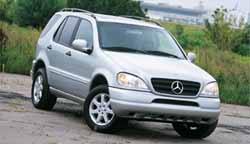 The convenience of the driver and passengers, capacity
The convenience of the driver and passengers, capacity The key difference of the Audi passenger body and off -road bodys of the remaining participants in the dough is the smaller salon height (from floor to ceiling) and less vertical landing on the seats. The disadvantage of the beneficial height in Audi is compensated by the larger ALLROD length not only longer than competitors, but also has more profitable than in BMW and Mercedes, the layout of the power unit. As a result, all four cars are quite close in terms of comfort in the passenger salon. It can only be noted that in Mercedes and BMW there are significantly more free space above the heads, and in Lexus, in order to conveniently accommodate behind, you have to enter the trunk with the help of the available longitudinal adjustment of the rear seat.
But in relation to the volume of the luggage compartment, both with raised rear seats and with folded ones, the explicit leader of Mercedes ML looms. At the same time, three outsiders look quite worthy and approximately the same.
Speaking about the convenience of the driver, you need to once again recall the fundamental difference in the height of the landing on the seat with peremptory fans of low sports landing behind the wheel is only Audi. In the other three cars, even using the high -altitude adjustment of the seat, it will not be possible to achieve a real low landing at the wheel.
Thanks to the adjustment of the steering wheel by inclination (BMW and Audi also have a length), as well as multiple seats adjustments, drivers of almost any physique will be able to take a convenient working pose in each of the four cars. The only remark refers to people of very high stature (from 190 cm) especially carefully check the convenience of landing in Mercedes and Lexus. Of the other comments on ergonomics, only a clear drawback of the side support of the Lexus seat was remembered. However, there are enough statics. Features of the design and equipment of four cars with a total value of about 250 thousand dollars can be described endlessly. It's time to compare their capabilities among themselves.
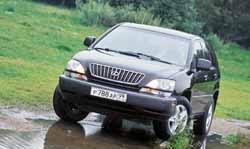 Longitudinal dynamics acceleration and braking
Longitudinal dynamics acceleration and braking They say that there are no power, like money. We do not undertake to judge money, but the power, or rather the dynamics of overclocking, the BMW X5 and Audi Allroad for Russian roads, at least, is quite enough. When overtaking on a narrow highway, trying to squeeze the maximum acceleration for the quick maneuver, at first you are mistaken and dangerously approach the overtaking car, not having time to rebuild into the oncoming lane. With such cars, you need to change the habit, and the main thing is not to be insolent to a state when it seems that you can do everything. Moreover, the implementation of power in acceleration does not require special driver’s skill of the automatic gearbox both on BMW and Audi works quickly, accurately and predictably. Manual switching mode is needed not for acceleration, but for braking with the engine and competent turning. On a winding road, you choose the right gear in advance before each turn and control the gas without fear of unnecessary intervention of the machine. Comparing BMW and Audi, it can be noted that BMW is a little more dynamic, but this is not the level of difference that makes the weather.
Mercedes ML 430 in the dynamics of acceleration is in the same category, but here the lag behind the BMW is already significant. The point is not even that the standard 100 km/h from the place of Mercedes spends half a second more. More importantly, in real road situations, Mercedes does not always demonstrate the one, almost perfect consistency in the operation of the engine and the transmission that we noted with BMW and Audi. Then the machine is slightly conceived, then the motor is unwound not so actively. Understand correctly no crime in the acceleration dynamics of the ML 430, but this is not a BMW X5.
Lexus RX 300, of course, lags behind the first trinity of a three -liter hopeless engine is clearly not enough to compete with them. Moreover, the complaints caused not so much the motor as the automatic box. Even 4-5 years ago, such a box would be quite at the level, now she clearly lacks the 5th gear, a faster reaction to Kick Down and manual control capabilities. As a result, Lexus, in comparison with competitors, accelerates sluggish, especially in low -speed traffic modes. The assessment of the brake qualities of all four cars, as expected, passed almost without comments. The word almost refers to the large free course of the brake pedal Mercedes ML. This is not to say that it interferes hard, but pays attention to itself.
 Controllability
Controllability The main element of parquet SUVs is still asphalt, so handling for them can be more important than cross-country ability. In this race, everything was originally put on Audi with a passenger body and low center of gravity. But it turned out that the victory of Allroad, at least, was controversial. The dark horse BMW X5 intervened the first model of the company in a high -crossed sector. Despite the high body, the BMW X5 is almost less than Audi to the rolls. In general, the controllability of both X5 and AlloD can be compared with the best samples of ordinary cars: accurate steering with high sensitivity and good feedback, straightforwardness stability and reliable behavior in the bends, reinforced by the operation of electronic stabilization systems. No comparison with traditional SUVs. Moreover, subjectively BMW we liked a little more he is more sporty and more acute.
The retired couple of Mercedes ML and Lexus RX 300 also does not have to scold controllability, but against the background of BMW and Audi their weaknesses are quite obvious. Mercedes ML practically does not have a reactive effect of steering. In the Lexus RX 300, the steering sins with some inaccuracy and, in addition, the front wheels in the bend begin to scream too early, warning of the upcoming demolition.
 Stroke, noise level, microclimate
Stroke, noise level, microclimate According to Russian concepts, interpreting the smoothness of the course as the ability of painless overcoming 10-centimeter failures in asphalt, all four cars are on top. Moreover, according to the energy intensity of the suspension, perhaps the best BMW X5. But before the breakdown, the rest of the competitors swallow the road surface defects softer, and Audi leads in this.
For other sections of comfort, the noise level and the organization of microclimate, all 4 cars cannot be accused of significant sins. Which is understandable for that kind of money without a good climate installation or an openly noisy car simply will not be sold.
 Cross -country ability
Cross -country ability And, finally, the last section of the test is cross -country, that is, what is praised by the advertisement of each of the four competitors. Especially actively, the theme of patency sounds in the Audi press releases, and the name Alload itself claims to be Land Rover laurels. Do not believe advertising all four cars are not all -terrain vehicles, and there is nothing wrong with that. These all -terrain vehicles are much worse adapted to daily road operation, the four cars that we have experienced are an excellent compromise between the convenience of daily operation and the level of cross -country ability that will satisfy at least 90% of the buyers of SUVs.
For obvious reasons, we did not even try to find out the marginal opportunities in the cross -country ability of cars. The cars are new, and alas, we do not belong to us. Nevertheless, certain conclusions can be drawn. In geometric patency, the leader is Mercedes ML with the shortest body overhangs, the largest angles of the exit entry and a decent clearance (200 mm). Mercedes differs from full -fledged all -terrain vehicles only with a low location of the frame and bottom of the body.
The second place in the same indicators is occupied by BMW, and the third Lexus. Audi Allroad, who has an adjustable clearance (from 142 to 208 mm), is an outsider into geometric patency due to huge overhangs, the smallest angles of entrance and the lowest floor floor (clearance and floor height above the ground is far from one and the same).
 By traction capabilities in off -road, again, Mercedes wins due to the presence of not only the anti -circus system, but also the demultipliter. In second place Audi, since the demultiplier is provided only for modification with a manual gearbox. The third place remains for BMW, which, just like Mercedes and Audi, is equipped with an anti -circus system, but is deprived of a lowering gear. And, finally, in the Lexus RX 300 rearguard without a demultipliter and anti -storm. The only device that increases Lexus traction capabilities on slippery coatings is the automatic blocking of the center differential with the help of viscose
By traction capabilities in off -road, again, Mercedes wins due to the presence of not only the anti -circus system, but also the demultipliter. In second place Audi, since the demultiplier is provided only for modification with a manual gearbox. The third place remains for BMW, which, just like Mercedes and Audi, is equipped with an anti -circus system, but is deprived of a lowering gear. And, finally, in the Lexus RX 300 rearguard without a demultipliter and anti -storm. The only device that increases Lexus traction capabilities on slippery coatings is the automatic blocking of the center differential with the help of viscose As a result, the victory in the off -road certainly gets Mercedes ML, the second place for BMW, the third in Audi and the latter belongs to the Lexus RX 300. You can correct these preliminary conclusions only after multilateral and expensive tests.
Results
So, it's time to summarize the impressions and make a choice between four expensive parquet SUVs from respected and prestigious manufacturers. For a driver of an enthusiast who especially appreciates the road behavior of a car (acceleration dynamics, controllability) and little interested in high cross-country ability, the choice is narrowed to two Audi Allroad and BMW X5. Audi is significantly cheaper, but this is not the main difference: BMW both externally and from the inside (high landing allows you to look at others around) is perceived as an SUV, and Audi as a car. Therefore, adherents of an all -terrain image will select BMW, while the rest remains to weigh the costs and their own addictions.
Audi Allroad
+
1. Great
acceleration dynamics
2. Very good
Passing
3. The opportunity
clearance changes
-
1. Low
geometric
cross -country ability
2. Lack of external
off -road image
BMW X5
+
1. Great
sports
controllability
2. Excellent
acceleration dynamics
3. expressive
corporate design
-
1. Small
road
enlightenment
2. High price
Mercedes ML 430
+
1. Large volume
luggage
departments
2. The best
at analogues,
cross -country ability
-
1. insufficient
reactive
action
steering
2. High price
Lexus RX 300
+
1. Comparatively
low price
2. Original
design
-
1. sluggish
acceleration dynamics
2. Loss
clutch
with Dorogov turn
it comes earlier
than analogues
If, in addition to the joys of active driving, the buyer is interested in a few better cross -country ability than Audi and BMW, as well as in a larger trunk, then you need to stop at the Mercedes ML 430. Lexus RX 300 was not leaders in any test nomination, but, with the other side, and did not demonstrate significant shortcomings. In addition, it is cheaper than other competitors. In a word, this is a very good compromise. And although Lexus is not as prestigious as BMW, Mercedes and Audi, over the past 10 years, thanks to the excellent comfort and the highest reliability of its cars, this brand has won a sustainable and decent status. For those who have passed this test of powerful parquet SUVs, there are not so many other competitors.
The alternative to the Audi Allroad can be the Volvo V70 XC (Cross Country) and Subaru Legacy Outback two spacious all -wheel drive station wagons (200 mm), but without the possibility of its regulation. Like Audi, Volvo and Subaru off -road modifications of ordinary cars. Subaru choice for economical. Its retail price begins with less than 40 thousand dollars. Naturally, it has smaller strength: 156 hp, providing with an automatic box only 10.6 seconds of acceleration to 100 km/h from the place. The strengths of Legacy Outback are handling, smoothness, capacity and quality of manufacture. The Volvo V70 XC both in cost and in the dynamics of acceleration occupies an intermediate position between Subaru and Audi. An additional charm of this model gives the novelty the car made a debut this year (do not confuse with the predecessor under the same name).
As for the BMW X5, Mercedes ML and Lexus RX 300, they have practically no analogues. With a strong stretch, an alternative can be considered Nissan Pathfinder, Jeep Grand Cherokee or Range Rover. Despite the huge difference in price (from 40 thousand dollars for Nissan up to 70 thousand for Range Rover), these cars are usually used the same as urban SUVs. However, in behavior on the road, especially in handling, they are significantly lagging behind BMW, Mercedes and Lexus, naturally surpassing them in cross -country ability.
Roman Sergeev
Photo by Alexander Nozdrin
A source: Cars






